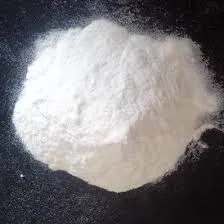
जुलाई . 10, 2024 16:33 Back to list
Similar chemical structures of HPMC and its derivatives for pharmaceutical applications
Hydroxypropyl methylcellulose (HPMC) is a substance that is commonly used in various industries, such as pharmaceuticals, food, construction, and cosmetics. It is a synthetic derivative of cellulose, which is a natural polysaccharide that is found in plant cell walls.
The chemical structure of HPMC is quite unique and plays a significant role in its properties and applications. HPMC is made by substituting hydroxyl groups of cellulose with hydroxypropyl and methoxyl groups. This modification results in a water-soluble polymer that has a wide range of viscosities and other properties depending on the degree of substitution.
The chemical structure of HPMC consists of a linear chain of glucose molecules with side chains of hydroxypropyl and methoxyl groups attached to the glucose units. The hydroxypropyl groups make the molecule hydrophilic, while the methoxyl groups increase its solubility in organic solvents. This dual nature of HPMC makes it suitable for use in both aqueous and non-aqueous systems.
In pharmaceuticals, HPMC is widely used as a thickening agent, gelling agent, and binder in tablet formulations. Its ability to form gels at low concentrations makes it a popular choice for controlling the release of drugs in various dosage forms. HPMC is also used as a coating material for tablets and capsules to improve their appearance and stability

hpmc chemical structure. In the food industry, HPMC is used as a food additive for various purposes, such as emulsification, thickening, and gelling. It is commonly found in products like ice cream, sauces, and baked goods to improve texture and mouthfeel. HPMC is also used as a fat replacer in low-fat and fat-free products. In the construction industry, HPMC is used as a thickening agent in cement-based products, such as mortar, plaster, and grouts. It improves workability, adhesion, and durability of these materials, making them easier to handle and apply. HPMC is also used in paints and coatings as a stabilizer and rheology modifier. In cosmetics, HPMC is used in a wide range of products, such as creams, lotions, and shampoos, as a thickener, emulsifier, and film former. Its film-forming properties create a protective barrier on the skin and hair, while its viscosity control properties ensure the desired texture and consistency of the product. In conclusion, the chemical structure of HPMC, with its hydroxypropyl and methoxyl groups, makes it a versatile and valuable ingredient in various industries. Its unique properties and applications continue to make it a popular choice for formulators looking to enhance the performance of their products.

hpmc chemical structure. In the food industry, HPMC is used as a food additive for various purposes, such as emulsification, thickening, and gelling. It is commonly found in products like ice cream, sauces, and baked goods to improve texture and mouthfeel. HPMC is also used as a fat replacer in low-fat and fat-free products. In the construction industry, HPMC is used as a thickening agent in cement-based products, such as mortar, plaster, and grouts. It improves workability, adhesion, and durability of these materials, making them easier to handle and apply. HPMC is also used in paints and coatings as a stabilizer and rheology modifier. In cosmetics, HPMC is used in a wide range of products, such as creams, lotions, and shampoos, as a thickener, emulsifier, and film former. Its film-forming properties create a protective barrier on the skin and hair, while its viscosity control properties ensure the desired texture and consistency of the product. In conclusion, the chemical structure of HPMC, with its hydroxypropyl and methoxyl groups, makes it a versatile and valuable ingredient in various industries. Its unique properties and applications continue to make it a popular choice for formulators looking to enhance the performance of their products.
Latest news
-
Versatile Hpmc Uses in Different Industries
NewsJun.19,2025
-
Redispersible Powder's Role in Enhancing Durability of Construction Products
NewsJun.19,2025
-
Hydroxyethyl Cellulose Applications Driving Green Industrial Processes
NewsJun.19,2025
-
Exploring Different Redispersible Polymer Powder
NewsJun.19,2025
-
Choosing the Right Mortar Bonding Agent
NewsJun.19,2025
-
Applications and Significance of China Hpmc in Modern Industries
NewsJun.19,2025
Related PRODUCTS







